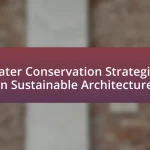Adaptive reuse is the process of repurposing old buildings for new uses while preserving their historical features, contributing to sustainability and cultural heritage. This article explores the differences between adaptive reuse and traditional renovation, highlighting key principles such as sustainability, historical preservation, and community integration. It discusses the importance of adaptive reuse in urban development, the types of buildings suitable for this practice, and successful examples like the High Line and Tate Modern. Additionally, the article addresses challenges, financial considerations, and best practices for implementing adaptive reuse projects, emphasizing the role of community engagement and stakeholder collaboration in achieving successful outcomes.

What is Adaptive Reuse?
Adaptive reuse is the process of repurposing old buildings for new uses while retaining their historical features. This practice not only preserves cultural heritage but also promotes sustainability by reducing the need for new construction materials. According to the National Trust for Historic Preservation, adaptive reuse can significantly lower carbon emissions associated with building demolition and new construction, making it an environmentally friendly option.
How does Adaptive Reuse differ from traditional renovation?
Adaptive Reuse involves repurposing an existing building for a new use while retaining its historical features, whereas traditional renovation focuses primarily on updating or restoring a building to its original condition or improving its functionality without necessarily changing its use. Adaptive Reuse often requires innovative design solutions to accommodate new functions, which can lead to sustainable practices by minimizing waste and preserving resources. In contrast, traditional renovation may not prioritize sustainability or the integration of new uses, as it typically aims to maintain the building’s original purpose.
What are the key principles of Adaptive Reuse?
The key principles of Adaptive Reuse include sustainability, historical preservation, functional adaptability, and community integration. Sustainability emphasizes minimizing waste and resource consumption by repurposing existing structures instead of demolishing them. Historical preservation focuses on maintaining the architectural integrity and cultural significance of the original building, ensuring that its historical value is respected. Functional adaptability involves modifying the space to meet contemporary needs while retaining its original character, allowing for diverse uses. Community integration highlights the importance of engaging with local stakeholders to ensure that the repurposed building serves the needs of the community and enhances the urban environment. These principles collectively contribute to the successful transformation of old buildings for modern needs.
Why is Adaptive Reuse important in urban development?
Adaptive reuse is important in urban development because it promotes sustainability by repurposing existing structures, thereby reducing the need for new construction and minimizing waste. This practice conserves resources and energy, as it often requires fewer materials and less energy than building new facilities from scratch. According to a study by the National Trust for Historic Preservation, adaptive reuse can save up to 50% of the energy typically consumed in new construction. Additionally, it helps preserve cultural heritage and community identity by maintaining historical architecture, which can enhance property values and attract tourism.
What types of buildings can undergo Adaptive Reuse?
Various types of buildings can undergo adaptive reuse, including industrial structures, warehouses, schools, churches, and historic homes. Industrial structures, such as factories, are often repurposed into residential lofts or commercial spaces due to their spacious layouts and robust construction. Warehouses can be transformed into retail centers or office spaces, capitalizing on their open floor plans. Schools and churches frequently find new life as community centers or event venues, preserving their architectural significance while serving modern functions. Historic homes can be adapted into boutique hotels or bed-and-breakfasts, maintaining their heritage while providing contemporary accommodations. This versatility in building types highlights the potential for adaptive reuse to meet current needs while preserving cultural and historical value.
How do historical buildings fit into Adaptive Reuse projects?
Historical buildings are integral to Adaptive Reuse projects as they provide a foundation for preserving cultural heritage while meeting contemporary needs. These structures often possess unique architectural features and historical significance, making them valuable assets in urban environments. For instance, repurposing a former factory into residential lofts not only revitalizes the area but also maintains the historical narrative of the community. Studies show that adaptive reuse can reduce construction waste by up to 80%, highlighting its sustainability benefits. By integrating historical buildings into modern developments, cities can foster a sense of identity and continuity while promoting environmental responsibility.
What are some examples of successful Adaptive Reuse projects?
Successful adaptive reuse projects include the High Line in New York City, which transformed an abandoned elevated railway into a public park, and the Tate Modern in London, which converted a former power station into a contemporary art museum. The High Line attracts millions of visitors annually, showcasing urban revitalization, while the Tate Modern has become one of the most visited art museums in the world, illustrating the cultural and economic benefits of adaptive reuse.
What challenges are associated with Adaptive Reuse?
Adaptive reuse faces several challenges, including structural limitations, regulatory hurdles, and financial constraints. Structural limitations arise when existing buildings do not meet modern safety codes or functional requirements, necessitating significant modifications. Regulatory hurdles often include zoning laws and historical preservation regulations that can complicate the approval process. Financial constraints are prevalent as adaptive reuse projects may require substantial investment for renovations, which can deter developers. According to a study by the National Trust for Historic Preservation, nearly 60% of adaptive reuse projects exceed their initial budget due to unforeseen structural issues and compliance costs.
How do zoning laws impact Adaptive Reuse initiatives?
Zoning laws significantly impact Adaptive Reuse initiatives by dictating the permissible uses of buildings and land within specific areas. These regulations can either facilitate or hinder the transformation of old structures into new functional spaces, depending on how they align with the intended use of the adaptive reuse project. For instance, if zoning laws restrict certain types of commercial activities in a residential zone, a developer may face challenges in converting an old factory into a mixed-use space that includes retail. Additionally, zoning codes may impose requirements for parking, building height, and design standards that can complicate or increase the costs of adaptive reuse projects. In cities like San Francisco, zoning adjustments have been made to encourage adaptive reuse, demonstrating that supportive zoning can lead to successful revitalization of historic buildings while preserving cultural heritage.
What financial considerations must be addressed in Adaptive Reuse?
Financial considerations in adaptive reuse include renovation costs, potential funding sources, and long-term financial viability. Renovation costs can vary significantly based on the building’s condition and the extent of modifications required; for instance, a study by the National Trust for Historic Preservation indicates that adaptive reuse projects can cost between $100 to $300 per square foot. Funding sources may include tax incentives, grants, and loans specifically aimed at historic preservation, which can offset initial expenses. Long-term financial viability must also be assessed through projected rental income, property value appreciation, and operational costs, ensuring that the project remains economically sustainable over time.

What are the benefits of Adaptive Reuse?
Adaptive reuse offers multiple benefits, including environmental sustainability, economic efficiency, and preservation of cultural heritage. By repurposing existing structures, adaptive reuse reduces waste and minimizes the need for new materials, thereby lowering carbon footprints. According to a study by the National Trust for Historic Preservation, renovating existing buildings can save up to 50% of the energy required to construct new ones. Economically, adaptive reuse can be more cost-effective than new construction, as it often requires fewer resources and can qualify for tax incentives. Additionally, preserving historical buildings maintains community identity and fosters a sense of place, which can enhance local tourism and property values.
How does Adaptive Reuse contribute to sustainability?
Adaptive reuse contributes to sustainability by minimizing waste and reducing the demand for new materials. By repurposing existing structures, adaptive reuse conserves resources and energy that would otherwise be expended in new construction. For instance, a study by the National Trust for Historic Preservation found that reusing a building can save up to 80% of the embodied energy compared to demolishing it and constructing anew. This practice not only preserves cultural heritage but also significantly lowers carbon emissions associated with construction activities.
What environmental advantages does Adaptive Reuse offer?
Adaptive reuse offers significant environmental advantages by reducing waste and conserving resources. By repurposing existing structures, adaptive reuse minimizes the need for new materials, which in turn decreases the environmental impact associated with manufacturing and transporting those materials. For instance, a study by the National Trust for Historic Preservation found that reusing a building can save up to 80% of the embodied energy compared to new construction. Additionally, adaptive reuse often leads to the preservation of historical architecture, which contributes to cultural sustainability and reduces the carbon footprint associated with demolition and new construction processes.
How does Adaptive Reuse promote community engagement?
Adaptive reuse promotes community engagement by transforming underutilized or abandoned buildings into vibrant spaces that serve local needs. This process often involves community input in the design and function of the new space, fostering a sense of ownership and pride among residents. For example, projects like the High Line in New York City have successfully turned an old elevated railway into a public park, attracting millions of visitors and encouraging local businesses to thrive. Such initiatives not only preserve historical architecture but also create venues for social interaction, cultural events, and community activities, thereby strengthening community ties and enhancing local identity.
What economic impacts does Adaptive Reuse have?
Adaptive reuse has significant economic impacts, including increased property values, job creation, and reduced construction costs. By repurposing existing structures, communities can revitalize neighborhoods, attracting new businesses and residents, which leads to higher demand for local services. For instance, a study by the National Trust for Historic Preservation found that adaptive reuse projects can generate up to 50% more jobs compared to new construction, as they often require more labor-intensive renovation processes. Additionally, adaptive reuse can lower overall construction expenses by minimizing the need for new materials and infrastructure, thus promoting sustainable economic growth.
How does Adaptive Reuse affect local property values?
Adaptive reuse positively affects local property values by increasing demand for revitalized areas. When old buildings are repurposed for modern use, they often attract new businesses and residents, leading to economic growth. For instance, a study by the National Trust for Historic Preservation found that adaptive reuse projects can increase property values by up to 20% in surrounding neighborhoods. This increase is driven by enhanced aesthetics, improved infrastructure, and the creation of vibrant community spaces, which collectively make the area more desirable.
What role does Adaptive Reuse play in job creation?
Adaptive reuse significantly contributes to job creation by revitalizing existing structures and stimulating local economies. This process often involves renovation and repurposing of buildings, which requires skilled labor in construction, design, and project management. For instance, a study by the National Trust for Historic Preservation found that adaptive reuse projects create approximately 20% more jobs per dollar invested compared to new construction. This job creation extends beyond construction, as repurposed buildings often house new businesses, further driving employment opportunities in retail, hospitality, and services.
How does Adaptive Reuse enhance cultural heritage?
Adaptive reuse enhances cultural heritage by preserving historical structures while adapting them for contemporary use. This practice maintains the architectural integrity and historical significance of buildings, allowing communities to retain their cultural identity. For example, the transformation of the High Line in New York City from an abandoned railway into a public park not only preserved the structure but also revitalized the surrounding neighborhood, fostering a sense of place and community. Studies show that adaptive reuse projects can increase local tourism and economic activity, further solidifying the cultural heritage of an area.
What is the significance of preserving historical architecture?
Preserving historical architecture is significant because it maintains cultural heritage and identity. Historical buildings serve as tangible links to the past, reflecting the architectural styles, materials, and craftsmanship of their time. For instance, the preservation of structures like the Colosseum in Rome or the Parthenon in Athens not only showcases ancient engineering but also attracts millions of tourists, contributing to local economies. Furthermore, studies indicate that adaptive reuse of historical buildings can reduce environmental impact by minimizing waste and conserving resources, as seen in the transformation of factories into residential lofts in urban areas. This practice not only honors history but also meets contemporary needs, demonstrating the dual importance of preservation in cultural and sustainable contexts.
How can Adaptive Reuse foster a sense of place in communities?
Adaptive reuse fosters a sense of place in communities by preserving historical structures while adapting them for contemporary use, thereby maintaining cultural identity. This approach allows communities to retain their architectural heritage, which can enhance local pride and continuity. For instance, the transformation of the High Line in New York City from an abandoned railway to a public park not only revitalized the area but also created a unique urban space that reflects the city’s history and character. Studies show that such projects can increase community engagement and economic activity, as they attract visitors and support local businesses, further solidifying the community’s identity and sense of belonging.

What are the best practices for implementing Adaptive Reuse?
The best practices for implementing adaptive reuse include thorough site analysis, community engagement, and sustainable design principles. Conducting a comprehensive site analysis helps identify the historical significance, structural integrity, and potential challenges of the existing building. Engaging the community ensures that the project meets local needs and preserves cultural heritage, fostering public support. Incorporating sustainable design principles, such as energy efficiency and the use of recycled materials, enhances the environmental benefits of the project. These practices are supported by case studies, such as the transformation of the High Line in New York City, which successfully integrated community input and sustainable design, resulting in a revitalized urban space.
How can stakeholders effectively collaborate on Adaptive Reuse projects?
Stakeholders can effectively collaborate on Adaptive Reuse projects by establishing clear communication channels and shared goals from the outset. This collaboration involves architects, developers, local governments, and community members working together to align their visions and expectations. For instance, regular meetings and workshops can facilitate the exchange of ideas and concerns, ensuring that all parties are informed and engaged throughout the project lifecycle. Additionally, utilizing collaborative tools and platforms can streamline information sharing and decision-making processes. Evidence of successful collaboration can be seen in projects like the High Line in New York City, where diverse stakeholders united to transform an old railway into a vibrant public space, demonstrating the effectiveness of cooperative efforts in achieving adaptive reuse objectives.
What roles do architects and urban planners play in Adaptive Reuse?
Architects and urban planners play crucial roles in adaptive reuse by designing and strategizing the transformation of existing structures for new purposes. Architects focus on the aesthetic and functional aspects, ensuring that the renovated spaces meet contemporary needs while preserving historical elements. Urban planners assess the broader context, considering zoning regulations, community impact, and sustainability, to create a cohesive integration of the repurposed buildings within the urban fabric. Their collaboration is essential for balancing preservation with innovation, as evidenced by successful projects like the High Line in New York City, which transformed an old railway into a vibrant public park, showcasing the effective application of adaptive reuse principles.
How can community input shape Adaptive Reuse outcomes?
Community input can significantly shape Adaptive Reuse outcomes by ensuring that the transformed spaces meet the needs and desires of local residents. Engaging community members in the planning process allows for the incorporation of their perspectives, which can lead to more relevant and sustainable uses of the repurposed buildings. For instance, studies have shown that projects with strong community involvement often result in higher satisfaction rates and increased usage of the spaces, as seen in the successful transformation of the High Line in New York City, where community feedback was integral to its design and function. This collaborative approach not only enhances the social value of the project but also fosters a sense of ownership among community members, ultimately leading to more successful and enduring Adaptive Reuse initiatives.
What strategies can ensure the success of Adaptive Reuse initiatives?
Successful Adaptive Reuse initiatives can be ensured through comprehensive planning, community engagement, and sustainable design practices. Comprehensive planning involves assessing the building’s historical significance, structural integrity, and potential for modern use, which helps in aligning the project with local regulations and community needs. Community engagement fosters support and input from local stakeholders, ensuring that the project meets the expectations and desires of those affected. Sustainable design practices, such as incorporating energy-efficient systems and using environmentally friendly materials, not only enhance the building’s functionality but also contribute to long-term viability and reduced environmental impact. These strategies are supported by case studies showing that projects with strong community involvement and sustainable approaches tend to achieve higher success rates and greater public acceptance.
How can funding be secured for Adaptive Reuse projects?
Funding for Adaptive Reuse projects can be secured through a combination of public grants, private investments, and tax incentives. Public grants are often available from local, state, or federal government programs aimed at preserving historical sites or promoting sustainable development. For instance, the National Park Service offers tax credits for the rehabilitation of historic buildings under the Historic Preservation Tax Incentives program. Private investments can be attracted by demonstrating the potential for return on investment through increased property values and rental income. Additionally, leveraging tax incentives, such as the Low-Income Housing Tax Credit for projects that include affordable housing, can further enhance financial viability. These funding sources collectively support the financial framework necessary for successful Adaptive Reuse initiatives.
What are the steps to conduct a feasibility study for Adaptive Reuse?
To conduct a feasibility study for adaptive reuse, follow these steps: first, assess the existing building’s condition and historical significance to determine its suitability for reuse. Next, analyze the market demand for the proposed new use, including demographic studies and economic trends. Then, evaluate zoning regulations and building codes to ensure compliance with legal requirements. After that, estimate the costs associated with renovation and potential funding sources. Finally, prepare a comprehensive report summarizing findings and recommendations, which should include a risk assessment and potential return on investment. These steps are essential for ensuring that the adaptive reuse project is viable and aligns with community needs and regulations.
What common pitfalls should be avoided in Adaptive Reuse?
Common pitfalls to avoid in adaptive reuse include neglecting structural integrity, overlooking zoning regulations, and failing to engage the community. Neglecting structural integrity can lead to safety hazards and increased costs, as seen in the case of the 2008 renovation of the historic St. Louis Post-Dispatch building, where unforeseen structural issues arose. Overlooking zoning regulations can result in legal complications and project delays; for instance, a project in San Francisco faced significant setbacks due to non-compliance with local zoning laws. Lastly, failing to engage the community can lead to resistance and lack of support, as demonstrated by the unsuccessful adaptive reuse of the former St. John’s Hospital in New York, where community opposition halted the project.
How can misalignment of vision among stakeholders be prevented?
Misalignment of vision among stakeholders can be prevented by establishing clear communication channels and shared objectives from the outset. Engaging all stakeholders in the planning process ensures that their perspectives and goals are aligned, fostering a collaborative environment. Research indicates that projects with defined stakeholder engagement strategies experience a 30% higher success rate, as seen in the case of the High Line in New York City, where diverse stakeholder input was integral to its adaptive reuse success. Regular meetings and updates can further reinforce alignment, allowing for adjustments based on feedback and evolving needs.
What are the risks of underestimating renovation costs?
Underestimating renovation costs poses significant financial risks, including budget overruns, project delays, and compromised quality. When renovation budgets are inaccurately assessed, property owners may face unexpected expenses that can escalate quickly, leading to financial strain. For instance, a study by the National Association of Home Builders found that 30% of renovation projects exceed their initial budgets due to unforeseen issues such as structural problems or outdated building codes. Additionally, these financial pressures can force project managers to cut corners, resulting in lower quality work and potentially unsafe conditions. Thus, accurate cost estimation is crucial to mitigate these risks and ensure successful renovation outcomes.
What practical tips can guide successful Adaptive Reuse?
Successful adaptive reuse can be guided by several practical tips: first, conduct a thorough assessment of the existing structure to identify its strengths and weaknesses, which helps in determining feasible modifications. Second, engage with the community to understand their needs and preferences, ensuring the new use aligns with local interests. Third, prioritize sustainability by incorporating energy-efficient systems and materials, as this not only reduces environmental impact but can also lower operational costs. Fourth, ensure compliance with local regulations and building codes to avoid legal issues during the transformation process. Lastly, collaborate with experienced architects and planners who specialize in adaptive reuse, as their expertise can enhance the project’s success and creativity. These strategies are supported by case studies showing that well-planned adaptive reuse projects often lead to increased property values and community revitalization.





